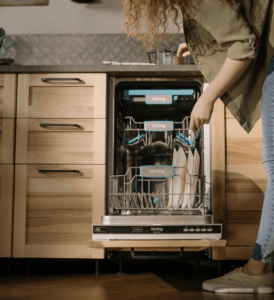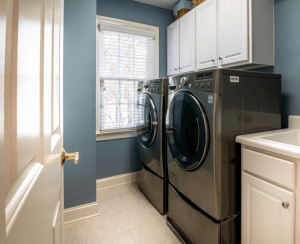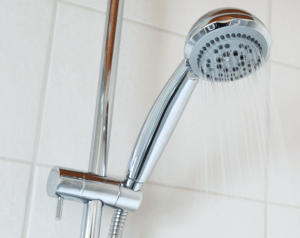When it comes to your common household appliances and fixtures, it seems almost inevitable that there may come a time when a leak will occur. Dishwasher leaking is one of the most common issues homeowners face, and while dishwasher leaking may seem minor, it’s important to take precautions to fix the current problem and prevent future dishwasher water damage from happening. When small issues are ignored, there can be a domino effect of costlier problems throughout your home.
Fixing household water leaks can also save homeowners about 10 percent on their water bills. Not to mention, preventing future water leaks and water damage can save families a lot of money on home repair expenses.
The EPA recently reported that minor water leaks account for more than 1 trillion gallons of water wasted each year in U.S. homes which is equivalent to the amount of water needed to wash 270 loads of laundry! Common types of leaks found in the home include both common appliances and fixtures, which are explained in more detail below. All are easily correctable.
Common Dishwasher Leaking Causes
There can be several issues that cause a dishwasher leak. When your dishwasher leaks from the bottom, there can be water from under the door that causes damage to wood floors and other parts of your kitchen! Some common leaking dishwasher causes include:
1. The Door may be improperly attached

If the dishwasher is leaking directly under the door, it may be improperly attached. The door should fit tightly into place but if it isn’t, it could allow water to enter through the gap. If water still runs from the door, check the gasket. The gasket is the rubber sealing on the door that is made to prevent water from flowing out of your dishwasher. It may be time to replace the gasket.
2. A leaky tub from corrosion and standing water
Over time, the seal between the tub and the wall can break down allowing water to flow through. This will most likely happen at the base of the tub where there’s no drain, causing water to collect under your dishwasher. You might also have broken valves, allowing water to pass through cracked seals.
3. The air vent on top of the sink
Check the air vent on top of the sink to see if it has water leaking from it. If it is, remove the knockout plug from the input where the water line enters the garbage disposal.
5. Overfilled Dishwasher
An overfilled dishwasher may develop a crack in the bottom of the dishwasher, allowing water to drip through and into the cabinet. If your unit takes in more water than it should, it won’t drain properly.
6. Incorrect Dishwasher detergent
Dishwasher Detergent is one of the biggest culprits when it comes to dishwasher leaks. Using the wrong detergent can bubble up the dishes and put pressure on the door seal, causing a water leak.
Why is my Dishwasher Leaking?
Understanding why dishwasher leaking occurs is the first step to prevention. There may be simple solutions such as using a different detergent, or not overfilling your dishwasher. Either way, dishwasher leaking can lead to water damage if these issues aren’t quickly resolved.
If you find that your dishwasher is leaking from the bottom, this is most likely due to a leaky gasket and can be indicated by water on the floor in front of the dishwasher. If you notice that the dishwasher is leaking from underneath, you could also have a cracked hose or faulty valves connection issue.
When you notice that there is a dishwasher leaking water, it is important to prevent further water damage from happening, such as damage to wooden cabinets or floors. You should first detect the exact location of the problem.
Next, turn off the water supply to your dishwasher. This is usually done via a valve located near the dishwasher, but may be in the basement depending on where you live.
Once the water has been shut off, make sure to use towels or other absorbent materials to soak up as much of the leaking water as possible. If there is standing, leaked water on your flooring, use a dry towel to absorb it before using a wet towel.
After you have cleaned up the water, you can check the dishwasher for any loose connections or broken pipes. You may need to remove some parts from your dishwasher door in order to get a clear view of the hose connections and couplings. Make sure to check if your appliance is still under warranty before you begin water damage repairs.
How to Fix Dishwasher Leaking Issues
Here are five steps to help you fix a leaking dishwasher:
- Turn off the power: Start by disconnecting the dishwasher from its power source. This is crucial for your safety during the repair process.
- Identify the source of the leak: Carefully inspect the dishwasher to determine where the leak is coming from. Common areas include the door seal, spray arms, tub, water inlet valve, and drain hose.
- Replace the door seal/gasket: If the leak is originating from the door area, check the door seal/gasket for damage or wear. Remove the old seal and replace it with a new one according to the manufacturer’s instructions. Make sure the new seal is properly aligned and securely attached.
- Clean or replace the spray arms: If the spray arms are clogged or damaged, they may cause leaks. Remove the spray arms and clean them thoroughly, ensuring there are no blockages. If the spray arms are damaged, replace them with new ones.
- Inspect and repair other components: Check the dishwasher tub, water inlet valve, and drain hose for any cracks, damage, or loose connections. If you find any issues, repair or replace the affected parts as necessary.
Note: If you are unsure about any step or if the problem persists after attempting these fixes, it’s recommended to consult a professional dishwasher repair technician.
Dishwasher Leaking into Basement
A dishwasher leaking into the basement is a serious concern. A common place to notice your dishwasher leaking is in your basement. If you notice puddles directly below the above dishwasher, you have a leak, even if there’s no sign of water on the kitchen floor. A problem like this needs attention immediately. You may have a water inlet pipe leak, and should pull the dishwasher out and inspect it immediately.
How do you dry a floor under a dishwasher?
- Turn off the dishwasher and shut off the water valve if it is continues to leak.
- Dry your floors immediately with a mop or towel so they’re completely dry.
- Place a fan or a small dehumidifier in the area of the leak to reduce the humidity and help dry it out.
Washer
What does it mean when the washer is leaking from the bottom? If you’ve seen any water leakage either the front or in the back after a wash cycle, this may mean you need to drain the water in the drain hose / water supply tube. This happens in both top-loading and front-loading washing machines. You can also refer to and carefully follow the manufacturer instructions for this process.
Refrigerator

It may be a good idea to shut off the water and check the drain pan underneath your fridge. It’s normal for the pan to have a slight amount of water, but if you are noticing a small pooling of water there may be a bigger issue and a technician can inspect the situation. Ignoring the situation could cause your kitchen floor to warp or lift and create a bigger expense later on.
Also, check to see if the fridge is level, as well as the defrost drain for a possible blockage, and the water supply line. If you find a leak behind the fridge, you may need to replace the plastic hose connected to the refrigerator. If the leak is bad enough, you may want to call a professional for refrigerator restoration.
Water Heater
As the electric water heaters heat up, it builds up the pressure inside the tank, which is slowly released by the safety valve. A damaged valve or faulty tank could be the issue, causing a potential flood or dangerous combustion.
If your water heater floods, you’ll find yourself ankle-deep in water that’s quickly soaking into your floorboards and creating the perfect environment for mold and mildew growth. In a situation involving a water heater, it’s always best to contact a technician who specializes in these systems.
HVAC System
Clogged air filters are the most common source of a leak in air conditioning systems. When your air filter is dirty, air cannot pass through as easily, which causes the evaporator coils to freeze up. The ice can eventually melt and create condensation on air ducts that could lead to larger damages in your home.
When the coils freeze, this leads to potential problems for your compressor. If you notice a frozen evaporator coil, turn the unit off immediately and do not turn it on again until the cause of the problem is remedied. Avoid frozen evaporator coils by replacing your air filter every 30-90 days and avoid covering any air vents or registers. Cracked drain pan or a clogged drain line are also possible issues causing a leak.
Faucet
With smaller fixtures like a sink, there are easy ways to fix the issue. Yet, if you notice water starting to affect the surrounding surfaces as well water damage could ensue. Wood shelving, cabinets, countertops, and floors are all at risk and begin to warp, crack, and rot from the continuous dripping of water.
Structural damage from water leaks can decrease the value of your home. It’s best to make the investment and solve the issue quickly with the help from a specialist when the problem has become a major issue.
Shower head

Another easy fix can be to unclog the shower head by soaking it in white vinegar. This helps to remove dirt and debris that may be affecting your water pressure flow. You may also need to replace an older rubber washer with a new one, clean or replace the diverter or cartridge valve.
Toilets
The most common toilet leak and often hardest to detect. This is caused by either a deteriorated or defected flush valve ball at the bottom of the toilet tank or an improperly adjusted or broken ballcock valve. If the flapper or ball valve does not seat properly and form a watertight seal, water will leak around it into the toilet bowl.
Often, this leak will occur without being heard. If the float is set too high and if the shut-off valve fails to close completely, water will continue to enter the tank and flow into the overflow tube, this type of leak can be seen by simply taking the tank top off and observing if the water is flowing into the overflow tube once the tank is full.
Water Damage Prevention
Preventing dishwasher leaking requires regular maintenance and quick action when issues arise. To prevent water damage from your appliances and fixtures, be sure to check nearby walls, corners and flooring to see where the water has traveled. If water has traveled near electrical circuits, then turn off the power, and use towels to dry off the areas thoroughly.
If your fixture or appliance is located in more of a damp, humid area, it’s a good idea to use a dehumidifier. This machine helps to reduce moisture and may help to prevent or reduce chances of mold growth in the areas that were affected by the leak.
Contact the Professionals
It’s important to keep your home leak-free by repairing your fixtures and appliances when you can. However, if you’ve thoroughly checked any of the above issues and still aren’t seeing any improvements, it may be time to further protect your home and call for professional repair.
Most common leaks can be eliminated after retrofitting a household with new WaterSense labeled fixtures and other high-efficiency appliances. In most cases, replacement parts don’t require a major investment; but in case of any larger leaks or any water damage, be sure to contact Jenkins Restoration for your water damage restoration needs.
Frequently Asked Questions
Why is my dishwasher leaking underneath?
The water pump of a dishwasher empties water out of the drain and delivers water to the wash cycle. Your dishwasher could leak if the pump is broken. The pump system has hoses that deliver water to the dishwasher and hoses that drain the water from the dishwasher.
How long do dishwashers typically last?
The average lifespan of a dishwasher is between 8 and 12 years. However, some models may last longer than others. If you want to extend the life of your dishwasher, try using a non-scratch detergent, and avoid washing dishes with abrasive materials such as plastic cutlery.
How to unclog dishwasher drain
If you want to unclog your dishwasher drain, you need to remove the rubber stopper from the bottom of the sink. Then, pour some baking soda into the sink, and let it sit for about 30 minutes. After that, run hot water through the sink until the soap bubbles stop coming out. Finally, rinse the sink thoroughly.
What causes dishwasher to leak from door?
If your dishwasher is leaking from your door, it may be improperly attached.
Can a clogged dishwasher filter cause a leak?
Yes, a clogged dishwasher filter can cause a leak. If the filter isn’t regularly cleaned, it can become clogged. When it become clogged, water cannot drain properly and will puddle inside, leading to a dishwasher leak from underneath.
What causes a dishwasher to leak out the front?
The most common cause for a dishwasher leaking out the front is usually a blocked air gap between the dishwasher and the door. Usually, your dishwasher and sink share a common drain. Some kitchen setups have an air gap to prevent any sink waste in the drains from backing up into the dishwasher and causing leaks.
